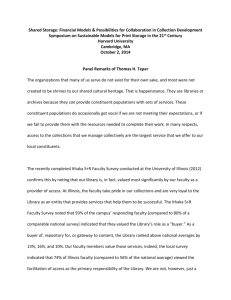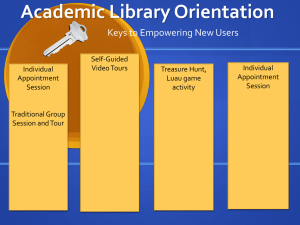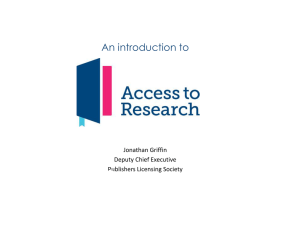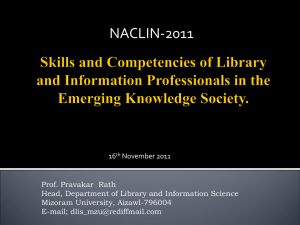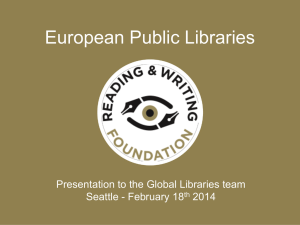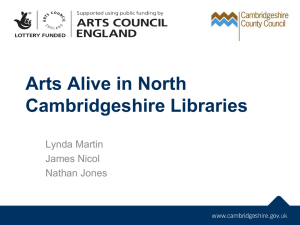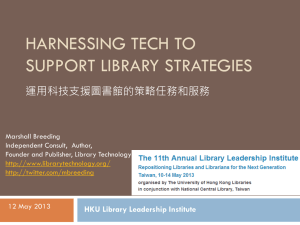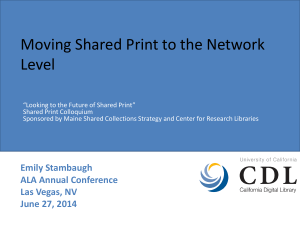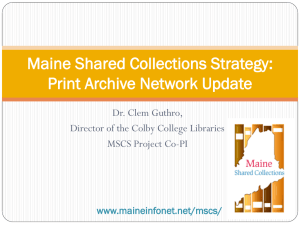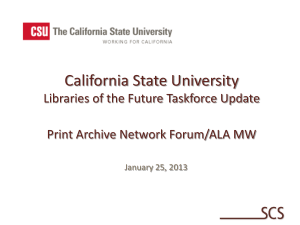Current Developments in Digital Library
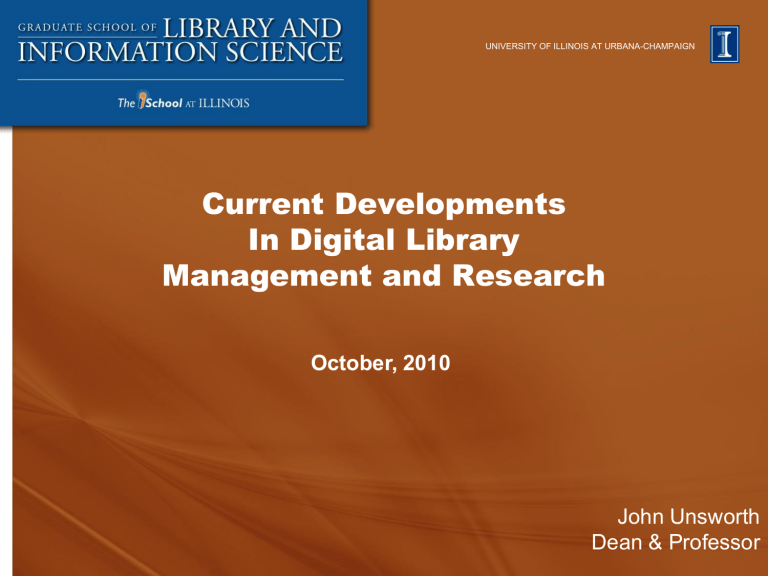
UNIVERSITY OF ILLINOIS AT URBANA-CHAMPAIGN
Current Developments
In Digital Library
Management and Research
October, 2010
John Unsworth
Dean & Professor
1924-25 senior class of the Library School at the University of Illinois (T.T. Yang, back row)
2
Digital Libraries: A Futuristic View
“The time isn't too far off, the experts say, when you'll wash your dishes without soap or water - ultrasonic waves will do the job. Your beds will be made at the touch of a button. The kids' homework will be made interesting when they are able to dial a library book, lecture or a classroom demonstration right into your home - with sound.
”
April 1959 Newsweek
More power to you! Brought to you by America's Independent Electric Light and Power Companies .
3
Digital Libraries: A Systems View
The DELOS Digital Library Reference Model 4
Digital Libraries: A Content View
The Czech National Digital Library 5
Digital Libraries:
An Institutional View
6
The World
Digital Library
http://www.wdl.org/
66 items for China
Digital Libraries
As Museums
7
The Digital Library:
A User ’s View
"As long as the centuries continue to unfold, the number of books will grow continually, and one can predict that a time will come when it will be almost as difficult to learn anything from books as from the direct study of the whole universe. It will be almost as convenient to search for some bit of truth concealed in nature as it will be to find it hidden away in an immense multitude of bound volumes." –
Dennis Diderot, “Encyclopédie”
(1755)
8
The Data Deluge
“The new availability of huge amounts of data, along with the statistical tools to crunch these numbers, offers a whole new way of understanding the world. Correlation supersedes causation, and science can advance even without coherent models, unified theories, or really any mechanistic explanation at all. There's no reason to cling to our old ways. It's time to ask: What can science learn from Google?
”
“The End of Theory: The Data Deluge Makes the Scientific Method Obsolete”
Chris Anderson, Wired Magazine 06.23.08
9
How Should Libraries and Librarians
Respond to the Flood of Information?
• What will libraries outsource?
• What must libraries do for themselves?
• What should libraries do together?
• What new roles are there for librarians?
10
What will libraries outsource?
Library Management Services? See OCLC ’s “Web-Scale
Management Services
” which proposes a shared
“cloud computing ” model for
• Circulation and delivery
• Print and electronic acquisitions
• License management
• Service configuration
• Workflow
• Cooperative business intelligence
11
Outsource: Books?
Google Books has already scanned a significant percentage of the holdings of research libraries.
Now “ Google Editions ” is about to shake up the publishing world with a cloud computing model of e-book distribution, opening any moment now..
How long will libraries need circulating collections?
12
Outsource: Journals?
We already rely on remote access to many journals, whether they are
• Open Access
• Non-profit
• For-profit
We are increasingly dependent on these journal distributors for long-term archiving, as well.
13
Outsource: Information Services?
For example, Elsevier ’s SciVal Spotlight, which debuted in China in
2009, uses co-citation analysis on the 16,000 journals in Scopus to “help leaders:
• Identify specific areas of research excellence, and emerging strengths, to use as comparative measures of performance among other institutions;
• Identify new research opportunities by displaying areas of expertise in a multidisciplinary view;
• Review competitive standing by tracking performance against major competitors for each area of research, and determine areas of research leadership that are at potential risk of being overtaken by competition; and
• Search for collaborators by determining potential sources for research collaboration.
”
14
Outsource: Archives?
Ten years ago, it was inconceivable that a single company might digitize the complete book holdings of a major research library.
What ’s inconceivable now?
Digitizing the archival holdings of libraries, which are orders of magnitude larger than library holdings.
But Google is already digitizing newspapers and magazines …
15
What must libraries do for themselves?
• Provide access to physical collections, especially unique items
• Develop collections, though these may not be physical holdings
• Manage collections and licenses, though this may be partly outsourced
• Help to design information services, though these may be delivered by others
• Deliver user education and user services
16
Institutional Repositories
Among the things academic libraries are increasingly doing for themselves is building and maintaining institutional repositories -- collections of scholarship and records created at their host institution.
DSpace and Fedora, two widely used Institutional
Repository software packages, have now combined as DuraSpace
Illinois has an institutional repository called IDEALS , that runs on DSpace.
17
What should libraries do together?
Shared Digital Repositories, like HathiTrust
California Digital Library
Indiana University
Michigan State University
Northwestern University
The Ohio State University
Penn State University
Purdue University
University of California Berkeley
University of California Davis
University of California Irvine
University of California Los Angeles
University of California Merced
University of California Riverside
University of California San Diego
University of California San Francisco
University of California Santa
Barbara
University of California Santa Cruz
The University of Chicago
University of Illinois
University of Illinois at Chicago
The University of Iowa
University of Michigan
University of Minnesota
University of Wisconsin-Madison
University of Virginia 18
HathiTrust
Contains material from library collections, digitized by Google and others
•6,856,780 total volumes
•3,946,095 book titles
•162,689 serial titles
•2,399,873,000 pages
•255 terabytes
•81 miles
•5,571 tons
•1,494,364 volumes (~22% of total) in the public domain 19
Services Built On Repositories
like SBDS , from the National Library of Australia
20
SBDS Connects Material from Multiple Sources
•
The Australian National Bibliographic Database
•Picture Australia
•Australian Research Online
•OAIster
•Open Library
•HathiTrust
•Wikipedia
•People Australia
•Australian Newspapers
•Archived copies of significant Australian websites
•
The National Library of Australia's manuscript finding aids
• The Library of Congress
•
Internet Archive
21
Digital Preservation
Library of Congress National Digital Information
Infrastructure Preservation Program :
“No one institution can tackle the challenge of digital preservation on its own. The Library of Congress has over 130 partners who share knowledge and experience.
”
22
What new roles are there for librarians?
• Collaborating in research (designing ontologies, organizing information, understanding users, etc.)
• Understanding, calculating, and sharing the value of information to library patrons
• Running “social-computational systems” to support data communities
• Publishing from unique library collections
• Publishing in conjunction with patrons
• Managing annotations
• Virtual librarianship
• Embedded librarianship
• New tools and services
23
New Tools and Services
MONK : a text-mining tool for digital libraries
SEASR : software environment for advancing scholarly research
24
National Science Foundation Program in Social-Computational Systems
…will support research in socially intelligent computing arising from human-computer partnerships that range in scale from a single person and computer to an Internet-scale array of machines and people. The program seeks to create new knowledge about the capabilities these partnerships can demonstrate [including] new models of collective, social, and participatory computing, and new algorithms that leverage the specific abilities of massive numbers of human participants.
25
Managing Annotations
http://www.openannotation.org/
26

